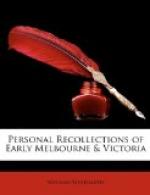The “gold escort” had been established by this time, with an armed guard, which at times included “native police,” a force which had been the best, if not the only, success as yet in our “civilizing” efforts with the aborigines. The art of digging had greatly advanced since my Ballarat visit. At Bendigo I inspected the “White Hills,” where there was already regular shaft-sinking to depths approaching 100 feet. The White Hills were so-called from a large ejection, piled up in white mounds of a light-coloured thick bed of the auriferous drifts, in which unprecedented quantities of gold had been found. Descending one of the shafts, I was shown the chief source of this gold, namely, a thin seam of small quartz grit, hardly two inches in thickness, and of the white quartz hue, excepting the lowest half inch, which was browned with iron. This lowest half inch had almost all the gold, and the very lowest part of it, where the iron-brown darkened almost to black, was literally crowded with gold particles. The diggers now always looked for the most gold where the quartz drift showed most of iron browning. Mr. Selwyn had not yet explained to us our Australian gold features and those gold “constants” of Murchison, which had to sustain so severe a shaking in Australia. I scraped out gold grains with my nails, and a good many with a knife within a minute. When I told the claim owners, that here was unlimited gold, and asked what they intended to do with it all, they pointed to the superincumbent mass of white stuff, which was either absolutely sterile, or, what was practically the same, had insufficient gold to pay even a run through the wash when ejected. The case seemed not unlike that of the thin seams of flint nodules (say nuggets) which characterize the thick chalk strata of South England, within which most or all the silicious matter of the entire bed has been somehow brought together. I understood that this remarkable gold seam gave out not long after, and that, thereupon, the marvellous yield of Bendigo was seriously diminished.
As we approached this already great and busy goldfield, when the hum of its business life was just breaking upon our ears, but without any other disturbing intrusion to interfere with the universally indigenous scene, a large kangaroo—the “old man,” or largest species—started up amongst the gum-tree underwood a little ahead of us, and bounded away in magnificent style. But a day or two afterwards,




